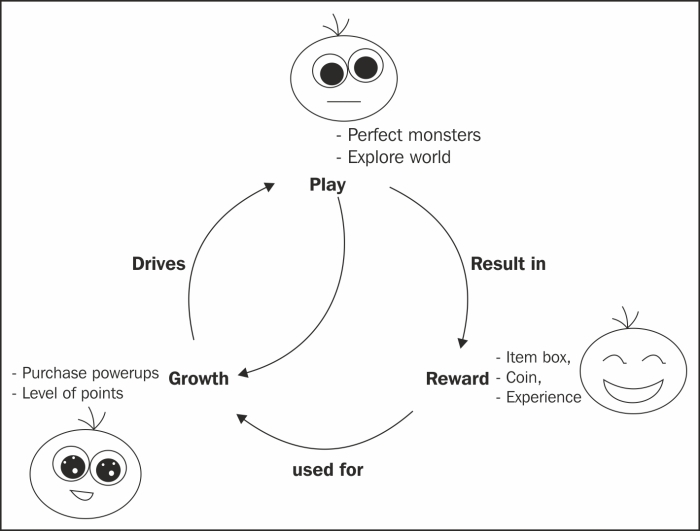I want to show you this diagram now because it contains a core concept that many novice developers might miss when writing their first games. A game can be complete with sound effects, graphics, realistic physics, and yet, still not feel like a game. Why is that?

Starting at the top of the loop, Play actions committed during the game (such as defeating a monster) result in rewards for the player (such as gold or experience). These rewards, in turn, can be used for in-game Growth (such as stats increases or new worlds to explore). This Growth then drives the gameplay in new and interesting ways. For example, a new weapon can change the basic mechanics of fighting, new spells let you take on groups of monsters with a completely different approach, or new modes of transportation can let you reach areas that were previously inaccessible.
This is the basic core loop that creates interesting gameplay. The key is that Play must result in some kind of Reward—think of glittering gold pieces popping out of nasty baddies. For rewards to have a point, it must result in some kind of Growth in the gameplay. Think about how many new locations were unlocked with the hook shot in The Legend of Zelda.
A game that is only Play (without Rewards or Growth) won't feel like a game: it will feel only like a really basic prototype of a game. For example, imagine a flight simulator with just an open world and no goals or objectives as well as without the ability to upgrade your plane or weapons. It wouldn't be much of a game.
A game with only Play and Rewards (but no Growth) will feel primitive and simple. The rewards will not satisfy the player if they cannot be used for anything.
A game with only Play and Growth (without Rewards) will just be seen as a mindless increasing challenge, without giving the player a sense of gratification for his achievements.
A game with all three elements will keep the player engaged with an entertaining Play. The Play has a rewarding result (loot drops and story progression), which results in the Growth of the game world. Keeping this loop in mind while you are devising your game will really help you to design a complete game.
Something you need to think about early in your game's development is your monetization strategy. How will your game make money? If you are trying to start a company, you have to think of what will be your sources of revenue from early on.
Are you going to try to make money from the purchase price, such as Jamestown, The Banner Saga, Castle Crashers, or Crypt of the Necrodancer? Or, will you focus on distributing a free game with in-app purchases, such as Clash of Clans, Candy Crush Saga, or Subway Surfers?
A class of games for mobile devices (for example, builder games on iOS) make lots of money by allowing the user to pay in order to skip Play and jump straight to the rewards and Growth parts of the loop. The pull to do this can be very powerful; many people spend hundreds of dollars on a single game.
